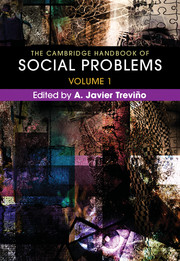Book contents
- The Cambridge Handbook of Social Problems
- The Cambridge Handbook of Social Problems
- Copyright page
- Contents
- About the Contributors
- Introduction
- Part I General Concerns and Orientations in the Study of Social Problems
- Part II Historical and Theoretical Issues in the Study of Social Problems
- Part III Problems of Discrimination and Inequality
- Chapter 17 Racism
- Chapter 18 Immigration
- Chapter 19 Gender Inequality
- Chapter 20 Sexualities and Homophobia
- Chapter 21 Poverty and Income Inequality: A Cross-National Perspective on Social Citizenship
- Chapter 22 Housing Market Discrimination
- Chapter 23 Hunger and Food Insecurity
- Chapter 24 Ageism, Past and Present
- Chapter 25 Disabilities
- Part IV Problems of Institutions
- Index
- References
Chapter 18 - Immigration
from Part III - Problems of Discrimination and Inequality
Published online by Cambridge University Press: 16 March 2018
- The Cambridge Handbook of Social Problems
- The Cambridge Handbook of Social Problems
- Copyright page
- Contents
- About the Contributors
- Introduction
- Part I General Concerns and Orientations in the Study of Social Problems
- Part II Historical and Theoretical Issues in the Study of Social Problems
- Part III Problems of Discrimination and Inequality
- Chapter 17 Racism
- Chapter 18 Immigration
- Chapter 19 Gender Inequality
- Chapter 20 Sexualities and Homophobia
- Chapter 21 Poverty and Income Inequality: A Cross-National Perspective on Social Citizenship
- Chapter 22 Housing Market Discrimination
- Chapter 23 Hunger and Food Insecurity
- Chapter 24 Ageism, Past and Present
- Chapter 25 Disabilities
- Part IV Problems of Institutions
- Index
- References
Summary
The United States is often described as a “land of immigrants,” yet not all immigrants are equally welcomed. Today, immigration is a heated topic in political campaigns and conversations, creating divisions, strong feelings, and emotions. The media depicts immigrants in negative, racialized terms dehumanizing their experiences. Such constructs fuel anti-immigration discourses and support laws that push immigrants to society's margins, making their lives invisible, dangerous, and difficult. Using a constructionism lens, we argue that negative constructions of immigrants as a problem are not representative of immigrants’ experiences or contributions to society. Immigrants contribute to American society through economic, cultural, and religious realms, yet laws and media, through constructions that are reproduced daily through technology, make it difficult for these contributions to be seen and acknowledged.
- Type
- Chapter
- Information
- The Cambridge Handbook of Social Problems , pp. 319 - 338Publisher: Cambridge University PressPrint publication year: 2018



